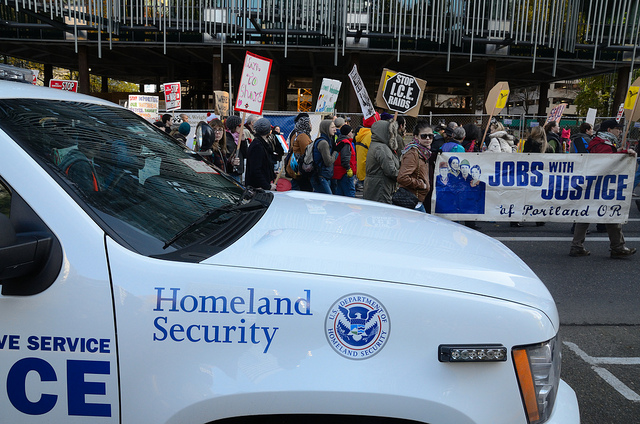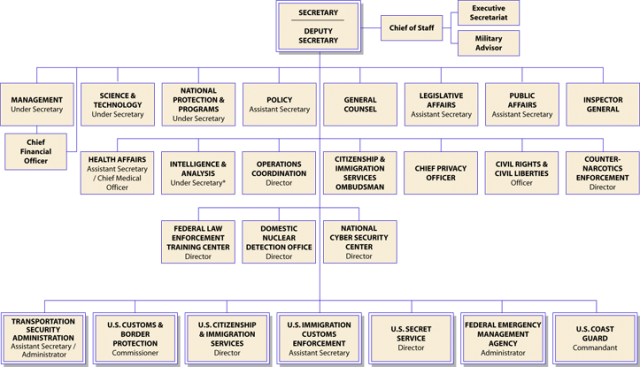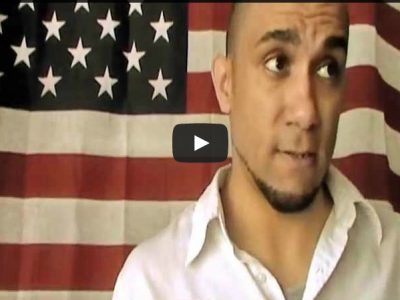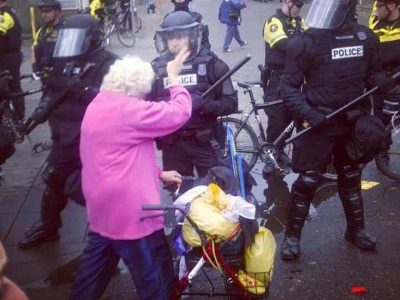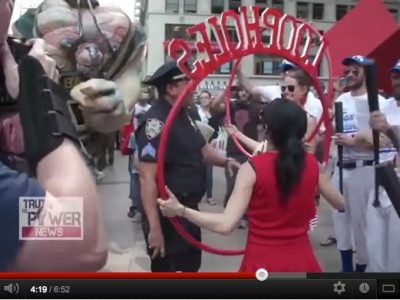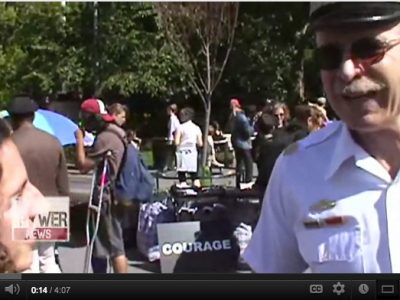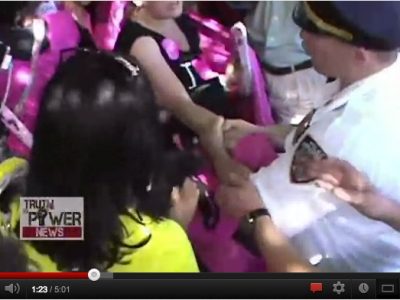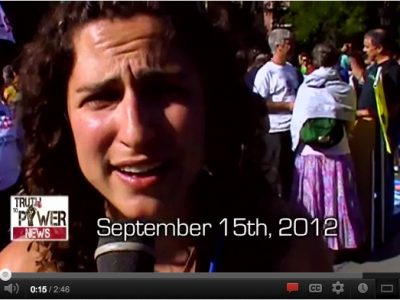by Adam Rothstein
DHS and Occupy: All Your Privacy Belongs to US
The Portland Occupier investigated documents released by the Department of Homeland Security under the Freedom of Information Act, and found a sea of holes. Through these holes, can be seen power, privilege, surveillance, investigation, intimidation, and an agency that literally answers to no one when deciding who and what can be investigated in the “defense of the homeland”. Is DHS investigating the Occupy movement? You bet it is. But as for where the line between State Security and The First Amendment is drawn by each of the twenty-six agencies that make up DHS, none of us mere citizens will ever know. And as these documents show–that is how DHS likes it.
DHS: One Agency to Rule them All
While we’ve heard details of the life support systems of a number of vampire squid over the past few years, none compares in size and scope of oppression to the Department of Homeland Security (DHS). A mere ten years old, it is the third largest Cabinet department, with two hundred thousand employees and a budget of nearly $100 billion per year. Its tentacles contain the remains of twenty-two former agencies, which reformed into twenty-six agencies, offices, and advisory groups (not including all subcomponents), under the massive, unblinking eye that is the DHS seal (stripping 180,000 employees of their union membership in the process).
But what does DHS do other than the eponymous, “fighting to secure the homeland”, as suggested by the ever eloquent George W. Bush? While the Department is no stranger to headline scandals involving a particular office or official, it is difficult to define the actual day-to-day activities of this large swath of the Federal budget. The fact is, the Department is engaged in so many activities, that its actual activity has become completely obscured. The question, “What is DHS not doing?” might be a better line of inquiry. From bridges, parks, waterways, health policy, internet regulation, science research, education, watching television broadcasts, screening mail–DHS is ensconced at every level of American life.
Merely asking DHS questions poses a problem (though a Secretary position does exist). To be precise: asking the question is not the issue, so much as receiving the answer. For example, if you were to ask DHS, “do you investigate protesters lawfully practicing their First Amendment rights?” you would receive the following from the Office of Civil Rights and Civil Liberties, which is tasked with giving such dismissive and yet open-ended answers:
Activities such as speech and assembly (both of which are implicated in the planned “occupy” protests) are protected by the First Amendment and generally DHS would not collect information or report on these types of activities unless we had a compelling interest to do so (emphasis added).
But rephrase the question to “would you show me every case in which you have investigated protesters lawfully practicing their First Amendment rights?” and the answer becomes much more complicated. In fact, you wouldn’t be given an answer at all. Instead, you would receive hundreds upon hundreds of pages of email, printed out and re-scanned, disorganized, unsorted, unlabeled, repeated, and censored. Your request for data regarding how your Federal government is spending your tax dollars on citizens like yourself, nets you a response of obfuscation, misdirection, spin, and outright lies. In the end, the information you receive will be incomplete, compartmentalized, restricted, and rendered nearly useless.
Enter the Doc Dump
This obsfuscation-through-PDF is what several news organizations recently received in response to their Freedom of Information Act (FOIA) requests to DHS. They asked for information: to whit, “All records, including emails, memoranda, letters, audio/video, transcripts, reports, including Threat Assessments, related to the protest movement known as “Occupy Wall Street.” DHS stalled. Arguing that it would take too long to retrieve those documents, they asked to limit the request only to records from senior officials (though supposedly the wider range request is “forthcoming”). The files they did release were heavily redacted emails and a few documents. Upon reviewing these files, one might deduce that the only thing that DHS does is send email–mostly in the form of reworded public statements.
But while these records provide nearly no direct information, their gaping holes reveal a wider and more valuable story. It is clear that these records are incomplete. Questions are asked in the emails, but never answered. Conference calls and face-to-face meetings are mentioned without reference point. PDFs, attachments, and web links are discussed but not displayed. Names of senior officials are redacted. Even the dates of the emails are redacted in some instances. There are numerous reports about the Occupy protests mentioned, yet the public is only privy to the part of the discussion focused on disavowing and burying those reports so they never will be seen. If we have learned one thing from this document dump, it is that the Freedom of Information Act is broken. While one can easily get scads of paperwork from a Federal Agency, receiving any information is difficult in the extreme.
This is not the first indication that DHS has problems in its relations with the Freedom of Information Act. After the Bush administration, DHS was backlogged by more than 74,000 requests. The fact that they were easily able to reduce that backlog to only a bit over 10,000 in two years does not speak highly for the Department’s attention to FOIA. But the problems didn’t stop there. In 2011, a Congressional probe into FOIA operations at DHS found that the political appointees were feuding with and obstructing the bureaucrats in charge of releasing material,as well as publicly ridiculing them. According to Politico: “In a 2009 email, Amy Shlossmann, Secretary Janet Napolitano’s deputy chief of staff, called a FOIA employee “a lunatic” and instructed her staff to attend a presentation by a career employee “if nothing else, for the comic relief.””
For Civil Liberties, Appearance is Substance
Senior DHS officials’ opinion of FOIA requests is palpable in the emails released in the Occupy dump; they mostly seem concerned as to how their Occupy investigations will play out in the press. From the very beginning of OWS, the bulletins released by component offices of DHS were accompanied by concerned emails from senior officials regarding potential press impact. In an email to colleagues dated September 29, 2011, Chris Ortman, spokesperson for DHS in the Office of Public Affairs, said:
Given the media coverage and the fact that we put an NCCIC [National Cybersecurity and Communications Integration Center] bulletin out on this [pre-Sept. 17, about Anonymous and Adbusters’ call for the Occupy protest in lower Manhattan], there’s a chance we may get questions about the Occupy Wall Street protests.
I’m thinking that we just make it clear that using social media to organize protests is well within constitutional rights; when it becomes our business is if social media is used by hacktivist groups to plan cyber attacks.
Being prepared for questions about Federal involvement in legal protest is a specialty area for these officials, who look to the Office of Civil Rights and Civil Liberties (CRCL) for talking points to demonstrate the Department’s purportedly high regard for citizens’ rights. In a CRCL email responding to a particular request for guidance, a policy advisor [name redacted] made the official line on OWS clear:
PRIV [the DHS Privacy Office] and CRCL supports the position that the Occupy Wall Street-type protesters mostly are engaged in constitutionally protected activity. We maintain our longstanding position that DHS should not report on activities when the basis for reporting is political speech. We would also be loath to pass DHS requests for more information on the protests along to the appropriate fusion centers without strong guidance that the vast majority of activities occurring as part of these protests is protected. To do otherwise might give the appearance that DHS is attempting to circumvent existing restrictions, policies, and laws.
To a large degree, these protests are no different from any other protests/events from civil liberties, civil rights and privacy perspectives. The issue is not the assembly of the groups, nor the message of the participants, it is only (as far as DHS is concerned) illegal or suspicious behavior related to a DHS mission that occurs during the protests. A possible exception would be reports on the environment created at the protests sites that would endanger public health and safety, where the health and safety concern relates to a DHS mission.
While it is nice to note concern regarding possible effects of DHS involvement on civil liberties, the reason officials solicited CRCL comment was because of their overall concern about the effect FOIA requests would have on public opinion, should DHS investigations into OWS be discovered. Scott Matthews, a Senior Policy Analyst for Intelligence, made the following comments commending Shala Byers. (Byers works in the Intelligence Coordination Branch of the State and Local Program Office, and first contacted the CRCL seeking guidance due to the number of requests coming in for information related to Occupy Wall Street.)
Most recently, Shala brought to Privacy and CRCL’s attention some incoming requests for information regarding the ongoing Occupy Wall Street-type protests. She recognized the potential hazards and brought the requests to our attention at a very early stage. Upon Shala’s request, Privacy and CRCL quickly drafted and coordinated guidance which was apparently disseminated shortly thereafter. As a result of the guidance, other components have reached out to Privacy and CRCL to better understand upon what to report concerning the protests.
I believe this was an excellent example of a coordinated effort by the offices involved to identify a potential problem, and takes steps to keep the problem from developing. I understand we have already received some FOIA requests regarding our possible reporting of the “Occupy…” protests. I think should the FOIA experts find it appropriate to release information about the manner in which this issue was managed within DHS, it could only be perceived as a positive by those in the public who closely observe the Department (emphasis added).
While the “potential hazards” of DHS offices investigating and disseminating information to other State and Local law enforcement entities include the violation of civil rights, unlawful prosecution, misappropriation of resources, and risk of injury and death to citizens due to heavy-handed policing, the potential public outcry due to information released by FIOA request seems to take the forefront in Matthews’ mind.
How to Investigate First Amendment Activity
But those who “closely observe the Department” would notice that the case for investigating Occupy Wall Street has already been established. Here are the guidelines that CRCL responded with, to Byers’ request:
Activities such as speech and assembly (both of which are implicated in the planned “occupy” protests) are protected by the First Amendment and generally DHS would not collect information or report on these types of activities unless we had a compelling interest to do so. Below is some general guidance that we hope you find helpful.
- The government may never collect or disseminate information based solely on First Amendment protected activities, or conduct investigations on that basis.
- Generally, reporting should be about the violence or criminality of a particular individual or group. Reporting on activities without a nexus to violence or criminality often raises First Amendment concerns.
- To justify research into and creation of a product containing First Amendment-protected activity, personnel should consider whether they have a lawful predicate (e.g. a lawful purpose to perform their authorized law enforcement functions or other activities, that is not based on the protected activity itself).
- Once a lawful predicate has been established, personnel should ensure the scope of the research and reporting on First Amendment-protected activity is limited to the threat posed. This is often referred to as congruence.
- The treatment of groups that may be involved in the First Amendment protected activity or related events should be even-handed and free of bias (e.g., not reporting more extensively or negatively on one group based on their viewpoint alone).
The close observer notes that the above does not counsel officials to avoid investigation into First Amendment protected activities, but instructs them how to “justify research into and reaction of a product containing First Amendment-protected activity.” These guidelines make it clear that personnel must have lawful predicate, and that the predicate is congruent to the investigation.
This is a difficult line to toe, and we must give investigators credit for walking the razor edge of double-speak and duplicity. Take for instance the case in which an analyst from the Homeland Counterterrorism Division sought help in defining how to investigate Occupy without investigating Occupy. It seems that in Eugene, Oregon, an SUV had been torched in an act of arson. There was graffiti related to the Occupy movement on the vehicle, however, according to Eugene police spokeswoman Melinda McLaughlin, it would be “unfair to blame any one group” for the arson, as “the graffiti was all over the map.” The analyst inquired as to “what objections CRCL might pose” to a report.
The CRCL discussed the matter. Two officials, names redacted, had the following conversation.
I expect that the analyst considers the single incident to be an incident of domestic terrorism (similar to ELF attacks on SUVs), and would argue that the DHS authority to report would be based on this being a suspected domestic terrorism incident. I think a reasonable case could be made for that.
W/r/t a larger report on the Occupy movement, do you mean that you don’t think CRCL could clear on any product on OWS, generally? I tend to agree that it would be difficult to clear on that, given that any concerns out of the movement thus far are local matters: reasonable time, place, and manner restrictions on protests, health and safety issues, etc, all seem to be situational awareness issues (not domestic terrorism-related) that apply only to locals dealing with particular protests, and therefore, lack a DHS nexus for reporting. Given that their only foray into illegal activity, as a movement, seems to be violating permit rules and clashes with the police over removals (mostly, but not exclusively, through civil disobedience tactics), a product would tend to appear as merely reporting on First Amendment activity.
The response:
My only point of divergence is that I believe a product written about the incident of vandalism, if it does not attribute the vandalism to OWS would not be a Homeland Security issue. Although this question falls within OGC’s authority to determine, if the basis for reporting is a single incident, not the general movement, the single incident does not appear to be a Homeland Security issue. I fear that no matter how you parse a potential report, any product on OWS which seeks to report on the movement in general, or the potential for violence nationwide would be largely reporting on First Amendment-protected activity.
This exchange with the Counterterrorism analyst suggests that if a report is filed, s(he) is to record the incident so as to downplay the focus on Occupy, even though that is the precise reason the incident would be reported.
If I&A [Intelligence and Analysis] believes the incident in Eugene merits nationwide reporting, it would be preferable for I&A to write up the incident in a manner that takes care not to attribute the action to Occupy (absent further information), rather than to write a general product about Occupy and add to that product a write-up of the incident (as the context of the product would make it difficult to convey that we have no information that the incident may be fairly attributed to Occupy, rather than someone merely sympathetic to their ideology). Generally, it would be difficult for DHS to justify a product on the Occupy movement at this time.
Their problem is significant. How does DHS investigate a crime potentially linked to a nationwide movement, if they cannot investigate that crime if it is linked to that movement? Either they must admit that they are possibly linking the crime to a movement centered around legal, First Amendment activity, or they cannot investigate the crime as part of a wider movement.
What was the result? Did the analyst, whose name was redacted, end up writing a “product” on the incident? We do not know, nor do we have any way of discerning, the analyst’s name, or the office in which he or she works.
Privacy is for the State
One might think that viewing these guidelines as allowing investigations into First Amendment protected activity is nothing more than a pessimistic reading. But let us recall that the effort of DHS officials is not to minimize investigation, but to minimize the public culpability such investigations might have, via documents released to the public record. The focus is never on the investigation itself, but on what the permanent record might contain. Said one official to another, both names redacted, on an email with date redacted:
I was advised by Scott Mathews that you are the point person for CRCL regarding the Occupy protests. FPS [Federal Protective Services] was notified of the guidance to the I&A [Intelligence and Analysis] representatives to restrict (emphasis added) production of all Occupy products absent criminal activity and/or life safety issues. FPS has followed this guidance and restricted and/or rescinded (emphasis added) all products (both internal and pass-through). FPS has been asked by GSA [General Services Administration] to provide a briefing on Occupy at the senior executive level. We are looking for additional guidance on the briefing. Would the attached document be acceptable to provide to GSA and other FPS stakeholders regarding Occupy or does it need to be limited any further?
Needless to say, the attachment itself wasn’t included in the released documents. But what we see here is the difference between “restricted” and “rescinded” in the bureaucratic jargon. They are not equivalent words, hence the “and/or”. “Rescinded” would seem to mean taking back reports that have been made. “Restricted”, on the other hand, would seem to mean that the documents still exist, only their visibility is obscured. It cannot mean “restrict the creation of documents”; how could the creation of a document be restricted, and also rescinded? It must mean that the reports exist, but are limited to a certain audience, and held confidential.
Of course, one of the main considerations in whether or not a document is released via the FOIA, is whether or not it falls into the restricted category. The exceptions to the FOIA include, per the DHS’ own letter to Truthout:
The deliberative process privilege protects the integrity of the deliberative or decision-making processes within the agency by exempting from mandatory disclosure opinions, conclusions, and recommendations included within interagency or intra-agency memoranda or letters. The release of this internal information would discourage the expression of candid opinions and inhibit the free and frank exchange of information among agency personnel. […]
Exemption 7(E) protects records compiled for law enforcement purposes, the release of which would disclose techniques and/or procedures for law enforcement investigations or prosecutions, or would disclose guidelines for law enforcement investigations or prosecutions if such disclosure could reasonably be expected to risk circumvention of the law.
In an unbelievable perversion of privacy that takes us across the border from the Orwellian State to the Carrollian Kingdom, the deliberative and decision-making process that defines exactly what can and cannot be investigated is held to be exempt from the FOIA. Whether or not DHS is respecting civil liberties is held to be a restricted, privileged form of conversation, exempt from public oversight, in order for officials to feel comfortable having candid opinions regarding just how they will or will not respect those civil liberties. Thus, the rights of DHS workers assume greater importance than those of common citizens.
It would appear that DHS was not obliged to release any records, whatsoever. According to their exemptions, all of the discussions about the decision-making processes behind investigative procedure could be restricted from public view. Therefore, we can conclude that they released records that, in the words of Scott Matthews, “could only be perceived as positive”. The attachment mentioned above, the missing info from emails, the actual Occupy investigations that did occur, and the referenced, but omitted conversations, can only be assumed to have violated the guidelines of CRCL, and therefore were “restricted”.
The FOIA-Documented Investigations of the Occupy Movement by DHS
Despite the restrictions, these documents reveal that DHS released reports, statements, or other “products” on the Occupy movement no less than fifteen times. If each of these instances indeed has a lawful predicate for producing the report, it seems that obstacle would be slight at most. Reports mentioned in these documents include:
- A bulletin by the National Cybersecurity and Communications Integration Center (NCCIC) about Anonymous and Adbusters’ call to protest, released sometime before September 17th.
- A report by Federal Protective Services (FPS) to the Philadelphia MegaCenter (MegaCenters are the DHS dispatch centers for FPS) about protests in New York City near a Federal Building, on October 5.
- Office of Emergency Management in Pittsburgh released a threat bulletin about Occupy Pittsburgh and Anonymous, that was forwarded to the Pennsylvania Criminal Intelligence Center, as well as other unknown agencies, sometime before October 6th.
- Shala Byers from State and Local Program Office (SLPO) asked for guidance from CRCL about the Occupy movement as the SLPO had “received a number of questions and requests for information regarding Occupy Wall Street from a number of component partners and intelligence officers.” She emailed this request on October 17th.
- The bureau of Alcohol, Tobacco, and Firearms (ATF) requested information from the Louisiana Fusion Center before October 18th, that was forwarded to Intelligence & Analysis (I&A). (Fusion Centers are DHS liason points for local law enforcement and other state and federal agencies.) The information they requested regarded violence towards the police by members of the Occupy movement, and any weapons that might have been confiscated from the Occupy movement. It is not known whether ATF was given any information, or what that information might have been.
- The United States Computer Emergency Readiness Team (US-CERT) and the Multi-State Information Sharing and Analysis Center (MS-ISAC) released an advisory about Anonymous/Antisec hacking IACP, Matrix Group, and other local law enforcement entities in solidarity with the Occupy movement. The advisory states that MS-ISAC investigated the hacks. The advisory was released on October 21st.
- The CRCL released their internal statement about the Occupy movement and First Amendment activity on October 24th. As the statement referenced the character of the movement thus far, it must have been paired with investigation and collation of information.
- Homeland Counterterrorism Division investigated, or at least prepared to investigate a SUV arson in Eugene, Oregon, in relation to Occupy Eugene, around or about October 24th.
- US-CERT and MS-ISAC released another advisory about Anonymous/Antisec hacking Oaklandpolice.com in retaliation for the eviction of Occupy Oakland on October 28th.
- The Domestic Security Alliance Council (DSAC) released an “unauthorized” bulletin, that was pulled down after it was noticed by officials, on October 28th.
- A report was filed with the Battle Creek MegaCenter about a protest in Kansas Cuty, MO, on October 30th.
- A Prism Demonstrations Abstract was released by the Secret Service about Occupy Wall Street activists protesting an appearance by George W. Bush, on November 3rd. The “case summary” also lists details of other protests from 9/17, 9/18, 9/19, 9/20, 9/21, 9/24, 9/26, so it seems that protests on these other dates must have at least been peripherally investigated by the Secret Service.
- The National Operations Center (NOC) released a Media Monitoring Bulletin about molotov threats made by protesters in New York City on YouTube, on November 16th.
- Matthew Chandler, in his role as Press Secretary for DHS, released a statement to the media confirming FPS’ role in removing protesters from Terry Schrunk Plaza in Portland, Oregon, on November 16th.
- Robert M. Davis (his position and office not clear) mentioned in an email that the next day, Washington DC will probably need FPS to help with “Key Bridge Activities”, on November 16. There’s no further mention of that incident, though on November 17th there was an Occupy DC protest march on the Key Bridge in Washington, DC. The Washington Post mentions the US Coast Guard being present (a division of DHS).
The Undocumented Investigations of the Occupy Movement by DHS
There is evidence pointing to several DHS investigations of the Occupy movement that are not mentioned in these documents. This is important to note, because it shows the failure of the FOIA process to uncover even the slightest bit of information about known investigations, thus provoking the questions: How many investigations exist of which we will never have knowledge, because they are not shown in the FOIA data? How can the public be expected to have oversight over its institutions, when concealing information from a FOIA request is so straightforward?
Fusion Centers
According the the DHS website, Fusion Centers are “State and major urban area fusion centers (fusion centers) serve as focal points within the state and local environment for the receipt, analysis, gathering, and sharing of threat-related information between the federal government and state, local, tribal, territorial (SLTT) and private sector partners.” The DHS site lists seventy-seven Fusion Centers: more than one for each state.
Despite the claim on the above site, that Fusion Centers are “uniquely situated to empower front-line law enforcement, public safety, fire service, emergency response, public health, critical infrastructure protection and private sector security personnel to lawfully gather and share threat-related information,” they appear to be beyond and outside of the purview of senior officials at DHS. As Andrew Lluberes, Director of Communication for Intelligence and Analysis said:
I&A scrupulously avoided and connection with the Occupy movement/protests/dismantlings. We cannot speak for any individual fusion center or other departmental component, but we issued no product to our customers and held no conf call with our field IOs on the subject.
Shala Bayers, in her request to CRCL for guidance, painted the Fusion Centers as a place to which SLPO might ‘pass the buck’, so that DHS would not have to hold the responsibility for investigating the Occupy movement directly:
We have received a number of questions and requests for information regarding Occupy Wall Street from a number of component partners and intelligence officers. Recognizing that this is a first amendment-protected activity, we have recommended (on an ad hoc basis when we received requests) that our Intelligence Officers refer inquiries to Fusion Centers and avoid the topic altogether.
Matthew Chandler, in his statement released to the press, said, “DHS is not actively coordinating with local law enforcement agencies and/or city governments concerning the evictions of Occupy encampments writ large.” While DHS itself was not coordinating, apparently the Fusion Centers– seventy-seven centers set up by DHS for the express purpose of coordinating with local law enforcement–were being pushed as the scapegoat for senior official culpability. We are aware, via senior official discussion, that requests for information were emanating from the Fusion Centers to the rest of DHS. But we have no evidence of these requests sent up the chain from the Fusion Centers. What else might have been happening between law enforcement and federal authorities at the Fusion Centers? Were the Fusion Centers in contact with each other? Where are the records for the “standard coordination calls and face-to-face meetings with our partners to ensure that the proper resources are available for operations,” as mentioned by Robert M. Davis to his superiors? The documents do not disclose the answers. The Fusion Centers are massive loose ends–all seventy-seven of them. Also clear is the fact that senior DHS officials took advantage of this knowledge, in order to block public scrutiny of their Occupy investigations.
The Ports
Occupy Oakland shut down the Port of Oakland during their General Strike on November 2nd. Less than two weeks later, Occupy Los Angeles made a call to occupy their ports. Despite the fact that DHS is responsible for maritime security, as well as security for all ports of entry to the United States, these events within the November 16th FOIA request date are mysteriously absent from any of the documents. Again, this reveals a massive blind spot within the scope of FOIA requests–or, like the Fusion Centers, and other reports missing from these documents, more examples of senior officials “restricting” information from public view.
Why Occupy: What Privacy and Oversight Mean
Information is a form of power. Giving information to the people about what their government is doing creates accountability. If the government then does anything of which the people and their representatives disapprove, the people can stop it. But without access to information, accountability goes begging. People must have access to the information; it must not be secretly and tacitly held by government in order to thwart necessary accountability.
Similarly, if the government is collecting information on its citizens, that is power over them. Even if the citizen is committing no crime, information does not have to be used as evidence in court to be powerful. Intimidation works by mere knowledge. All an agent of the government need do is confront a person on the street, and tell them they are being watched. This happens to activists. Those struggling to bring accountability to the government and their leaders are harassed, followed, and intimidated by government employees. Such actions say: “We have the unlimited, unrestrained authority and resources of the federal government to watch you, and all you have is yourself, and the hope you don’t do anything wrong”. Sometimes, even if you don’t screw up, they may get you anyway, because, remember, they are the government and they hold all the information. Who can tell them they are wrong?
The issue is not just about suspicion, paranoia, and about “who is watching the watchmen”. This is about the very constitution of what constitutes Federal authority. This is about the Constitution, with the capital “C”. A popular stimulus for the Occupy movement, and one of the many ideas currently resonating in society, is that the Federal government no longer works to serve the people, but only to serve itself. It consolidates power, resources, tax dollars, and structures all of society around these circuitous feedback loops that make the government its own reason for being. “Security” is a faceless, brainless, heartless argument for the Federal government to exist. The idea that agency operational secrecy must be maintained, so that said government agency can guard Federal buildings off limits to ordinary citizens, has so far warped the logic of a government purportedly “by the people and for the people” as to make “democracy” an unintelligible word. How can we claim to have a representative government, when the only thing that such security apparatuses defend are themselves, and the culpability of those who work for them?
Federal Government Security, in this day and age, defines the reinforcement of the idea of Security that protects its own continued existence. Agencies like DHS are forced to investigate any and every threat to this hegemony of power, by intimidating those who speak too loudly, or point their fingers in the wrong direction. Because if a group like Occupy were to successfully challenge the idea that we needed a Federal government to define, restrict, and defend “Security”, that would be the end of such behemoths as DHS.
That, after all, is what the Occupy movement is here to do. Occupy serves to point that finger. It calls out the government for being complicit in the consolidation of power and money. By vociferously practicing free speech, and by demonstrating against the malfeasance of the government and corporations, it breaks that loop. Occupy demonstrates against State oppression by demonstrating that State Security is State Oppression.
DHS may hide behind the walls of Federal buildings and Fusion Centers, dodge FOIA requests and media questions, violate the First Amendment and harass citizens. But the Occupy movement is not going away.

